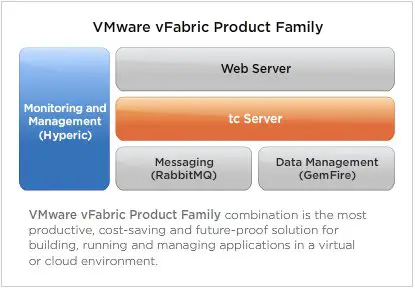After having a month to reflect on the organized chaos that was VMworld 2011, one message still stands out to me most of anything we heard during that week. VMware conveyed loud and clear that apps, and more specifically the frameworks and middleware to enable cloud apps, are the big area of innovation for the next era of computing. In the VMware world, they are calling it all vFabric. Cloud applications are going to take rethinking, rewriting and re-architecting to really make use of cloud.
VMware is positioning itself as the developers’ friend, much in the same way Microsoft did when the desktop era dawned. The 2009 acquisition of SpringSource that left many, including myself, wondering what VMware was thinking, but the technology is now emerging as a critical part of the VMware ecosystem and vision for the future. The middleware for developers is a critical third piece of the VMware vision of cloud which will bridge the two other primary foci of the company.
VMware has long been the king of the virtual infrastructure game. Their vSphere suite and the type 1 ESX hypervisor are a mainstay in nearly all datacenters around the world. VMware also got its beginnings with its type 2 Workstation and now VMware Fusion hypervisors. But as enabling the cloud, a true run-anywhere architecture and bring your own hardware initiatives have emerged, the two disparate product areas left a gap the company has been working to fill.
Based around the virtual infrastructure VMware has developed, the cloud posed a new set of problems that could only be solved by rewriting traditional client/server applications into cloud apps with distributed data models, distributed processing and distributed display logic across multiple datacenters. And when thinking of cloud, the first thing to come to mind are applications that Google and Facebook have written and how they are architected to be highly available and redundant.
What is vFabric?
The vFabric line up is a multi-product library of solutions to provide developers with the frameworks and middleware needed to build out products on cloud architecture. The focus is clearly on web applications using customized or VMware-branded versions of the Apache Web Server and Apache Tomcat, known as vFabric Web Server and vFabric tc Server, to develop Java web applications which use the Spring framework. In addition to the presentation and processing layers, there are also products to handle messaging, monitoring and data storage. In particular, this year VMware announced innovation to add to the GemFire data models, including a new in-memory SQL solution called SQLFire. GemFire and SQLFire both seek to upend competitors like Oracle and Microsoft’s traditional relational database products, which VMware is calling out as bottlenecks. Even while the bottleneck may be true, the real idea is a distributed data model where the data does not exist in a single instance database but rather in a mesh of systems on a cloud architecture. To me, that is the real difference and news with GemFire.
Looking back & moving forward
While I don’t claim to be a Java developer, I can certainly see a clearer picture of the vision VMware has for cloud. I was not fortunate enough to attend VMware 2010, so perhaps things would have began to be clearer had I attended, but 2011 certainly provided the clarity I needed.
The unfortunate side to all of this is that VMware is now attempting to engage a new audience of developers, which are catered to in a very different way than the systems administrators and infrastructure staff they have traditionally engaged with. Saying it in a different way – they have moved past me a bit, as one of the systems guys, and are working on things that excite me less. I realize we must have applications, but I’m not the guy who writes them, so the thrill of announcements at VMworld 2011 was less for me, than at past conferences.
VMware certainly has a learning curve of how to engage developers, too, but the SpringSource acquisition provided them with a solid foundation and a good set of roots in the open-source community. For now, I hear that the user communities will remain separate with VMUG’s and Spring User Groups existing beside one other, which is smart. Hopefully, the same will hold true for the future with VMworld and other events as well. What I most hope is that their message does not become muddled and muddy because they now have two different audiences to cater to.

